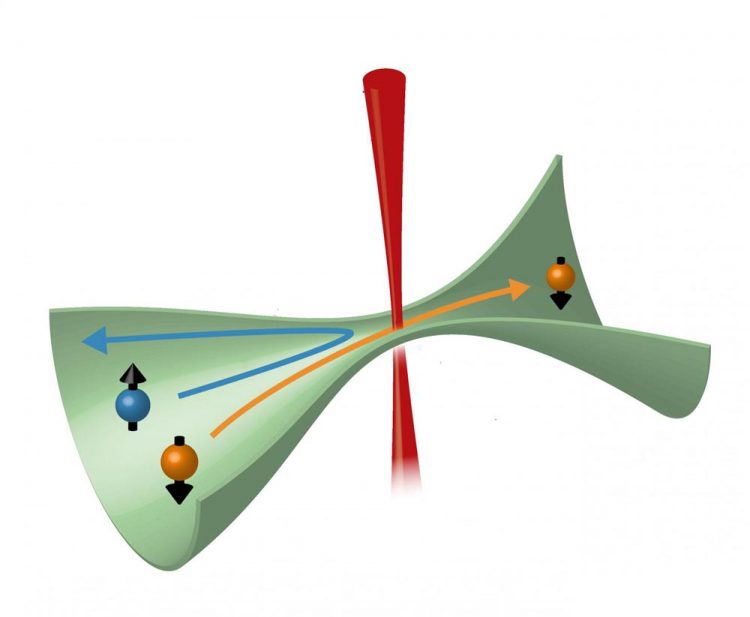A distinct spin on atomic transport

An optical beam (red) introduces an effect equivalent to applying a magnetic field inside an optically defined structure in which the atoms move (green). Atoms in the energetically lower spin state (orange) can flow while atoms in a higher spin state (blue) are blocked. Credit (ETH Zurich/D-PHYS, adapted from doi: 10.1103/PhysRevLett.123.193605)
One of the more unexpected things that can be done with charge-neutral atoms is to use them to emulate the fundamental behaviour of electrons. In the past few years, the group of Tilman Esslinger at the Institute of Quantum Electronics in the Department of Physics of ETH Zurich has pioneered a platform in which atoms cooled to temperatures close to absolute zero are transported through one- and two-dimensional structures, driven by a potential difference.
In this way defining phenomena occuring in mesoscopic electronic systems can be studied in great detail, not least quantized conductance. In a pair of papers published today in Physical Review Letters and Physical Review A, postdoc Laura Corman, former PhD student Martin Lebrat and colleagues in the Esslinger group report that they have mastered in their transport experiments control over another quantum property of the atoms — their spin.
The team added to the transport channel a tightly focussed light beam, which induces local interactions that are equivalent to exposing the atoms to a strong magnetic field.
As a consequence, the degeneracy of the spin states is lifted, which in turn serves as the basis for an efficient spin filter: atoms of one spin orientation are repelled, whereas those of another orientation are free to pass (see the figure).
Importantly, even though the application of an additional light field leads to the loss of atoms, these dissipative processes do not destroy the quantization of conductance. The ETH researchers replicate this experimental finding in numerical simulation and substantiate its validity through an extension of the Landauer–Büttiker model, the key formalism for quantum transport.
The efficiency of the atomic spin filter demonstrated by the Esslinger group matches that of the best equivalent elements for electronic systems. This, together with the extraordinary 'cleanness' and controllability of the cold-atom platform, opens up exciting new perspectives for exploring the dynamics of quantum transport.
In particular, as the interaction between the atoms can be tuned, the platform provides access to spin transport of strongly correlated quantum systems. This regime is difficult to study otherwise, but is of considerable fundamental and practical interest, not least for applications in spintronic devices and to explore fundamental phases of matter.
Media Contact
All latest news from the category: Physics and Astronomy
This area deals with the fundamental laws and building blocks of nature and how they interact, the properties and the behavior of matter, and research into space and time and their structures.
innovations-report provides in-depth reports and articles on subjects such as astrophysics, laser technologies, nuclear, quantum, particle and solid-state physics, nanotechnologies, planetary research and findings (Mars, Venus) and developments related to the Hubble Telescope.
Newest articles

First-of-its-kind study uses remote sensing to monitor plastic debris in rivers and lakes
Remote sensing creates a cost-effective solution to monitoring plastic pollution. A first-of-its-kind study from researchers at the University of Minnesota Twin Cities shows how remote sensing can help monitor and…

Laser-based artificial neuron mimics nerve cell functions at lightning speed
With a processing speed a billion times faster than nature, chip-based laser neuron could help advance AI tasks such as pattern recognition and sequence prediction. Researchers have developed a laser-based…

Optimising the processing of plastic waste
Just one look in the yellow bin reveals a colourful jumble of different types of plastic. However, the purer and more uniform plastic waste is, the easier it is to…


